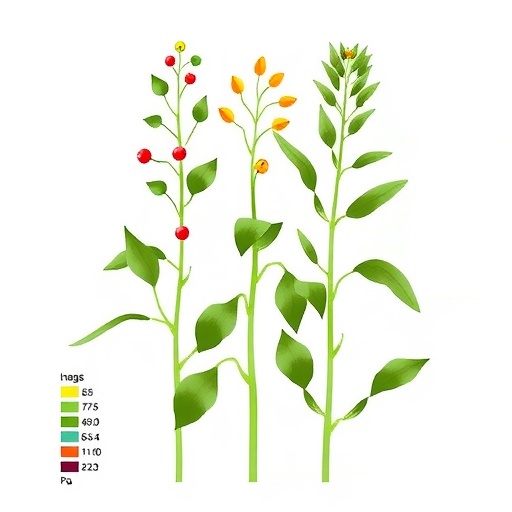
In the relentless quest to secure sustainable and nutritious food sources for a burgeoning global population, scientists have turned their attention to underutilized indigenous crops with immense potential. An exemplary breakthrough in this arena is the recent comprehensive genetic mapping of Gynandropsis gynandra, a resilient indigenous leafy vegetable prized for its nutritional and agronomic attributes. This breakthrough was meticulously detailed by Simpson, Sogbohossou, Reeves, and colleagues in their 2025 groundbreaking paper published in npj Sustainable Agriculture. Their work not only charts a genetic blueprint vital for the crop’s improvement but also opens doors to enhancing food security and nutritional quality in vulnerable regions.
Gynandropsis gynandra, often known as spider plant or African cabbage, is an indigenous crop native to parts of Sub-Saharan Africa and South Asia. Despite its rich nutritional profile, containing essential vitamins, minerals, and antioxidants, this crop remains underexploited in modern agriculture. Its adaptability to harsh environmental conditions such as drought and poor soils makes it a prime candidate for sustainable farming systems in changing climates. Genetic resources for this crop have historically been limited, hindering breeding efforts aimed at improving its yield, nutritional content, and suitability for mechanized agriculture.
The research team embarked on a comprehensive genomic investigation to unravel the genetic basis underlying key agronomic traits, nutritional qualities, and notably, the morphological characteristics of leaf vein architecture – a relatively unexplored trait with implications for photosynthetic efficiency and drought tolerance. Through state-of-the-art next-generation sequencing technologies and high-density genetic marker development, the scientists constructed the first high-resolution linkage map for Gynandropsis gynandra. This map serves as a crucial scaffold for pinpointing quantitative trait loci (QTLs) related to traits vital for crop improvement.
.adsslot_BNYdXyrTqW{width:728px !important;height:90px !important;}
@media(max-width:1199px){ .adsslot_BNYdXyrTqW{width:468px !important;height:60px !important;}
}
@media(max-width:767px){ .adsslot_BNYdXyrTqW{width:320px !important;height:50px !important;}
}
ADVERTISEMENT
Their analysis identified multiple QTLs associated with agronomic performance, including flowering time, plant height, and biomass accumulation. These traits directly influence the adaptability and yield potential of the crop, especially under variable climatic conditions. Understanding the genetic control of flowering time is particularly important in aligning crop maturation with favorable environmental windows, ensuring optimal harvests and resource use. The elucidation of genetic regions governing these traits offers breeders molecular targets to fast-track the development of improved varieties.
Crucially, they also mapped loci linked to nutritional quality parameters, such as enhanced folate content, vitamin C concentration, and antioxidant capacity. These traits contribute significantly to the dietary value of Gynandropsis gynandra, which is already considered a superfood in traditional diets. By leveraging these genetic insights, breeding programs can strategically amplify these nutraceutical properties, addressing micronutrient deficiencies that are prevalent in many developing regions and thus supporting global health outcomes.
One of the most innovative aspects of the study was the focus on leaf vein traits, which have profound effects on photosynthetic efficiency and water-use optimization. Leaf vein density and patterning influence hydraulic conductivity and nutrient transport, impacting the plant’s resilience to drought stress. The researchers successfully identified genomic regions responsible for variation in vein density and architecture, suggesting potential genetic pathways to engineer improved photosynthate distribution and stress tolerance. This dimension of genetic characterization represents a frontier in crop improvement science that could revolutionize leafy vegetable breeding.
In addition to laboratory-based sequencing and mapping, the research incorporated field phenotyping across diverse climatic conditions to ensure that the genetic associations discovered are relevant under realistic agricultural scenarios. This holistic approach ensures that any future genetically enhanced varieties retain their robustness and nutritional advantages outside controlled environments. The incorporation of multi-environment trials also aids in understanding genotype-by-environment interactions, a critical factor for breeding resilient crops amid global climate variability.
The paper discusses the potential to employ marker-assisted selection (MAS) as a powerful tool to expedite breeding cycles for Gynandropsis gynandra. MAS allows breeders to screen seedlings for desirable traits using DNA markers linked to target QTLs rather than relying solely on phenotypic observations, which can be time-consuming and environment-dependent. The availability of these genetic markers thus dramatically increases breeding efficiency, reducing time and costs while enhancing selection accuracy.
Furthermore, the researchers emphasize the importance of integrating these genetic advancements with local farmer knowledge and traditional practices. Such participatory approaches ensure that newly developed varieties meet the expectations of food preferences, culinary uses, and cultural values, thereby promoting adoption and long-term sustainability. Engaging local communities in breeding strategies can lead to impactful agricultural transformations that empower indigenous farming systems.
The study also highlights the significance of Gynandropsis gynandra as a climate-smart crop. Its inherent drought tolerance, coupled with the identified genetic variants associated with water-use efficiency, underscores its suitability for dryland agriculture. As climate change intensifies water scarcity, crops that maintain productivity under limited water availability will be instrumental for food security. The ability to genetically enhance these traits through informed breeding reinforces Gynandropsis gynandra’s role in resilient food systems.
Moreover, the research sheds light on the species’ genetic diversity, revealing substantial variation within wild and cultivated populations. This genetic reservoir provides a valuable source for breeders to harness useful alleles for crop improvement. Conservation of such genetic diversity is crucial, especially as environmental changes and agricultural intensification threaten indigenous plant genomes worldwide.
In light of the global push toward diversifying food sources and reducing reliance on staple crops, this study positions Gynandropsis gynandra as a key candidate for inclusion in sustainable agricultural portfolios. Its nutritional benefits align with the goals of improving dietary diversity and combating malnutrition. The genetic tools developed thus contribute to global efforts to create resilient, nutritious, and culturally acceptable food systems.
The researchers also propose future directions that include genomic selection approaches and genome editing technologies to further accelerate the improvement of Gynandropsis gynandra. With continuing advancements in CRISPR and other gene-editing platforms, precise modifications enabling enhanced nutritional content or stress resilience can be envisioned. Integrating these approaches with the foundational genetic knowledge will streamline the development of superior cultivars tailored for target environments.
This landmark study serves as a testament to the power of combining modern genomic tools with traditional crop breeding knowledge. By unlocking the genetic secrets of an often-overlooked indigenous leafy vegetable, Simpson and colleagues have paved the way for innovations that could have broad-reaching implications for sustainable nutrition, climate adaptation, and agricultural biodiversity. Their work reinforces the critical value of underutilized crops in shaping the future of global food systems.
Ultimately, the success of translating these genetic insights into tangible agricultural outcomes depends on interdisciplinary collaboration among plant geneticists, breeders, agronomists, nutritionists, policymakers, and farmers. Such a concerted effort ensures that scientific breakthroughs catalyze real-world impacts, fostering food sovereignty and environmental sustainability in diverse agroecological landscapes. This study exemplifies how cutting-edge science can champion indigenous crop revitalization in the quest for global sustainability.
By charting a robust genetic roadmap for Gynandropsis gynandra, this research not only augments our understanding of plant genetics and function but also celebrates the untapped potential of indigenous crops in addressing the intertwined challenges of malnutrition, climate change, and sustainable agriculture. It marks a critical milestone in the paradigm shift toward inclusive and diversified food systems, reinforcing the imperative to invest in and protect genetic resources that lie beyond conventional staples.
Subject of Research: Genetic mapping and trait analysis for agronomic performance, nutritional enhancement, and leaf vein architecture in the indigenous crop Gynandropsis gynandra.
Article Title: Genetic mapping for agronomic, nutritional, and leaf vein traits in the indigenous crop Gynandropsis gynandra.
Article References:
Simpson, C.J.C., Sogbohossou, D.E.O., Reeves, G. et al. Genetic mapping for agronomic, nutritional, and leaf vein traits in the indigenous crop Gynandropsis gynandra.
npj Sustain. Agric. 3, 33 (2025). https://doi.org/10.1038/s44264-025-00074-0
Image Credits: AI Generated
Tags: adaptation to harsh environmental conditionsagricultural innovation for sustainable food sourcesbreeding efforts for Gynandropsis gynandrafood security in vulnerable regionsgenetic mapping of indigenous cropsgenetic resources for crop improvementGynandropsis gynandra traitsindigenous crop potential in Sub-Saharan Africanutritional quality of indigenous vegetablesresilience of Gynandropsis gynandrasustainable agriculture practicesunderutilized leafy vegetables


